Marketing Culture Report: Singapore vs America Analysis
VerifiedAdded on 2020/04/13
|17
|2699
|339
Report
AI Summary
This report provides a detailed analysis of the marketing culture in Singapore, comparing it to the United States. It begins with an introduction to market culture and its impact on marketing effectiveness. The report then presents the rationale for choosing Singapore, highlighting its multicultural population and global significance. A cultural analysis of the United States is conducted, focusing on its unique cultural components like artifacts, adopted values, and ratified values. The report then examines the business culture of both countries, emphasizing the differences in economic overview, business environment, workforce, language, and taxation. The impact of unique cultures on international business is discussed, followed by an application of Hofstede’s cultural dimensions to understand cultural differences and their implications for business operations, including power distance, individualism, masculinity, uncertainty avoidance, and indulgence. The conclusion summarizes the advantages of cultural diversity and the importance of understanding cultural differences for successful international business. This report leverages secondary data to support its analysis and provides valuable insights into the cultural dynamics of international marketing.
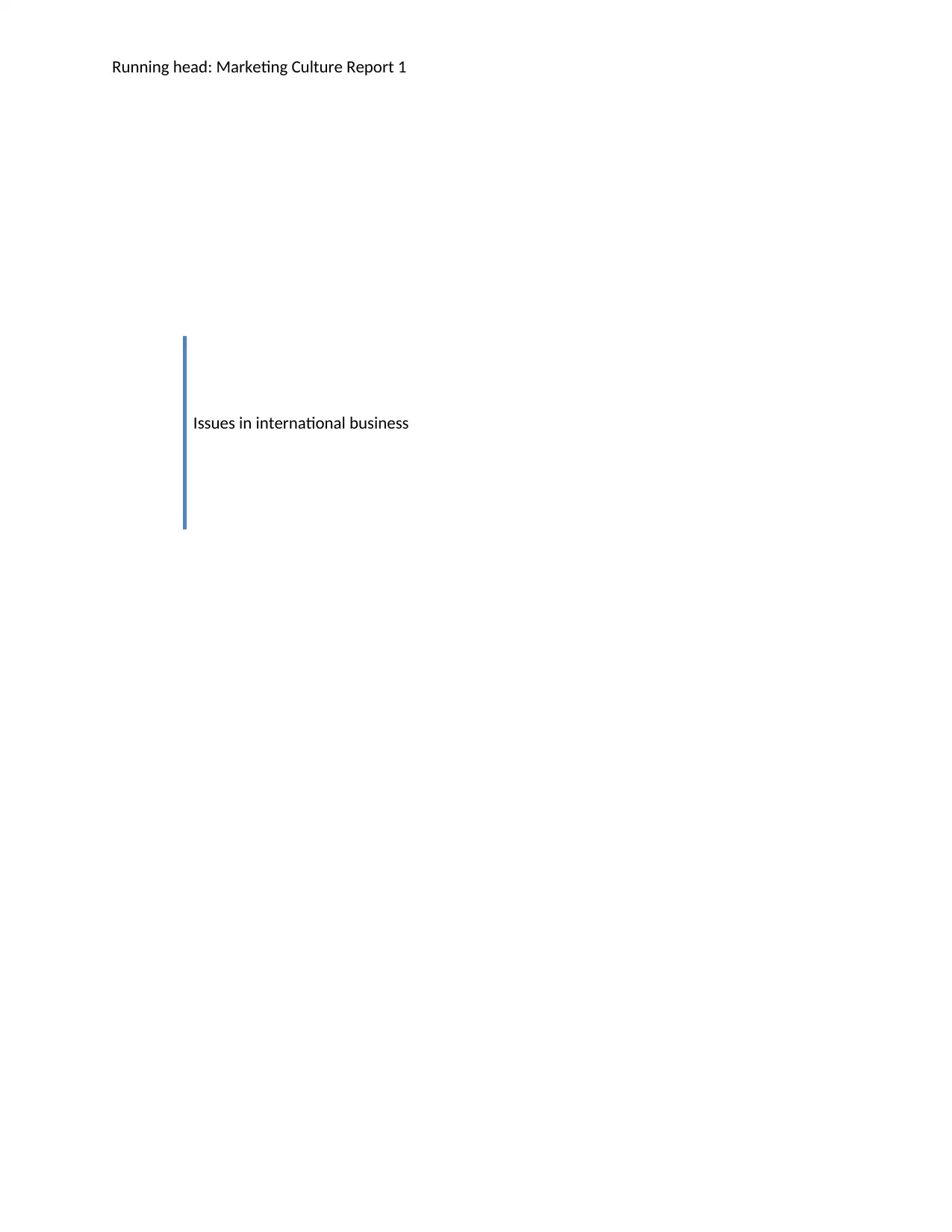
Running head: Marketing Culture Report 1
Issues in international business
Issues in international business
Paraphrase This Document
Need a fresh take? Get an instant paraphrase of this document with our AI Paraphraser
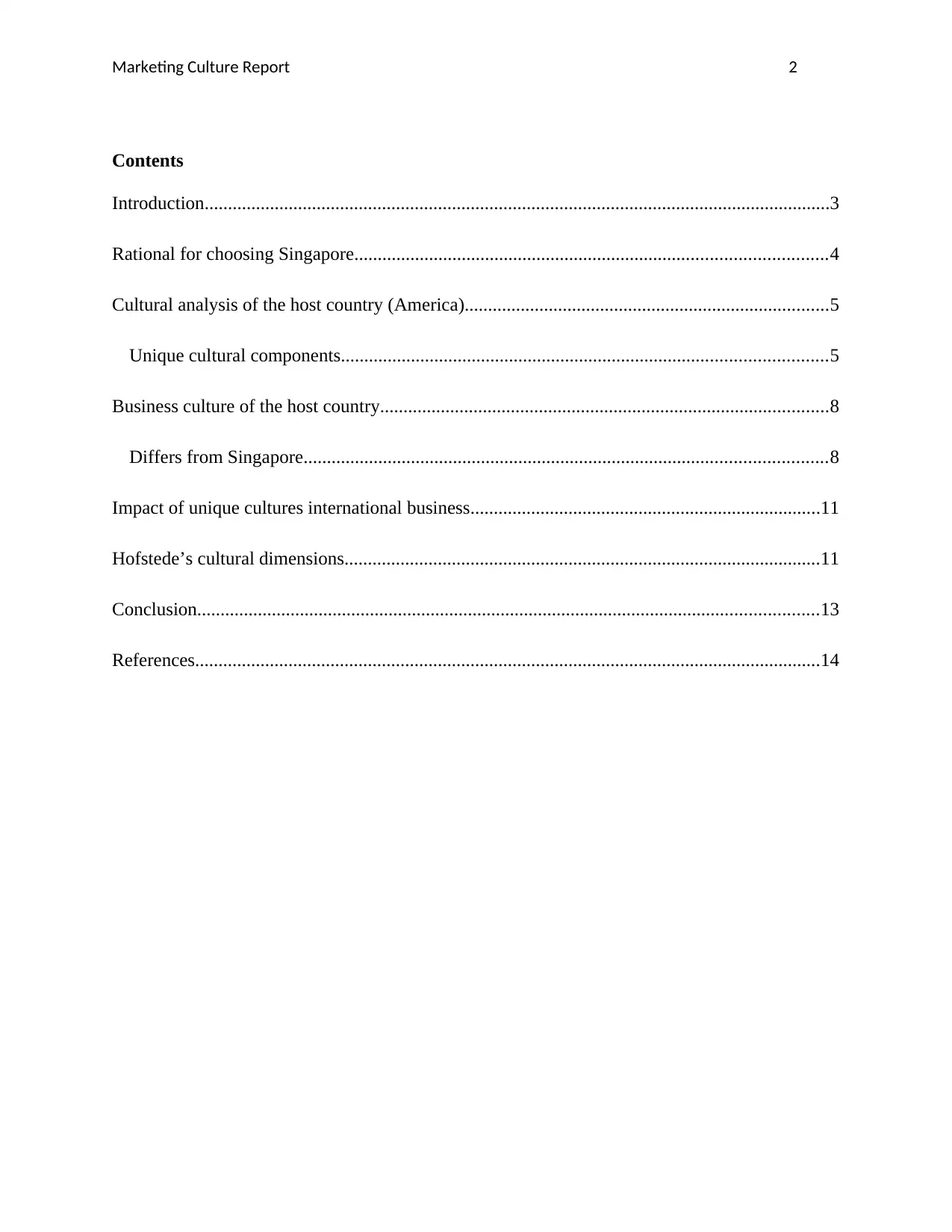
Marketing Culture Report 2
Contents
Introduction......................................................................................................................................3
Rational for choosing Singapore.....................................................................................................4
Cultural analysis of the host country (America)..............................................................................5
Unique cultural components........................................................................................................5
Business culture of the host country................................................................................................8
Differs from Singapore................................................................................................................8
Impact of unique cultures international business...........................................................................11
Hofstede’s cultural dimensions......................................................................................................11
Conclusion.....................................................................................................................................13
References......................................................................................................................................14
Contents
Introduction......................................................................................................................................3
Rational for choosing Singapore.....................................................................................................4
Cultural analysis of the host country (America)..............................................................................5
Unique cultural components........................................................................................................5
Business culture of the host country................................................................................................8
Differs from Singapore................................................................................................................8
Impact of unique cultures international business...........................................................................11
Hofstede’s cultural dimensions......................................................................................................11
Conclusion.....................................................................................................................................13
References......................................................................................................................................14
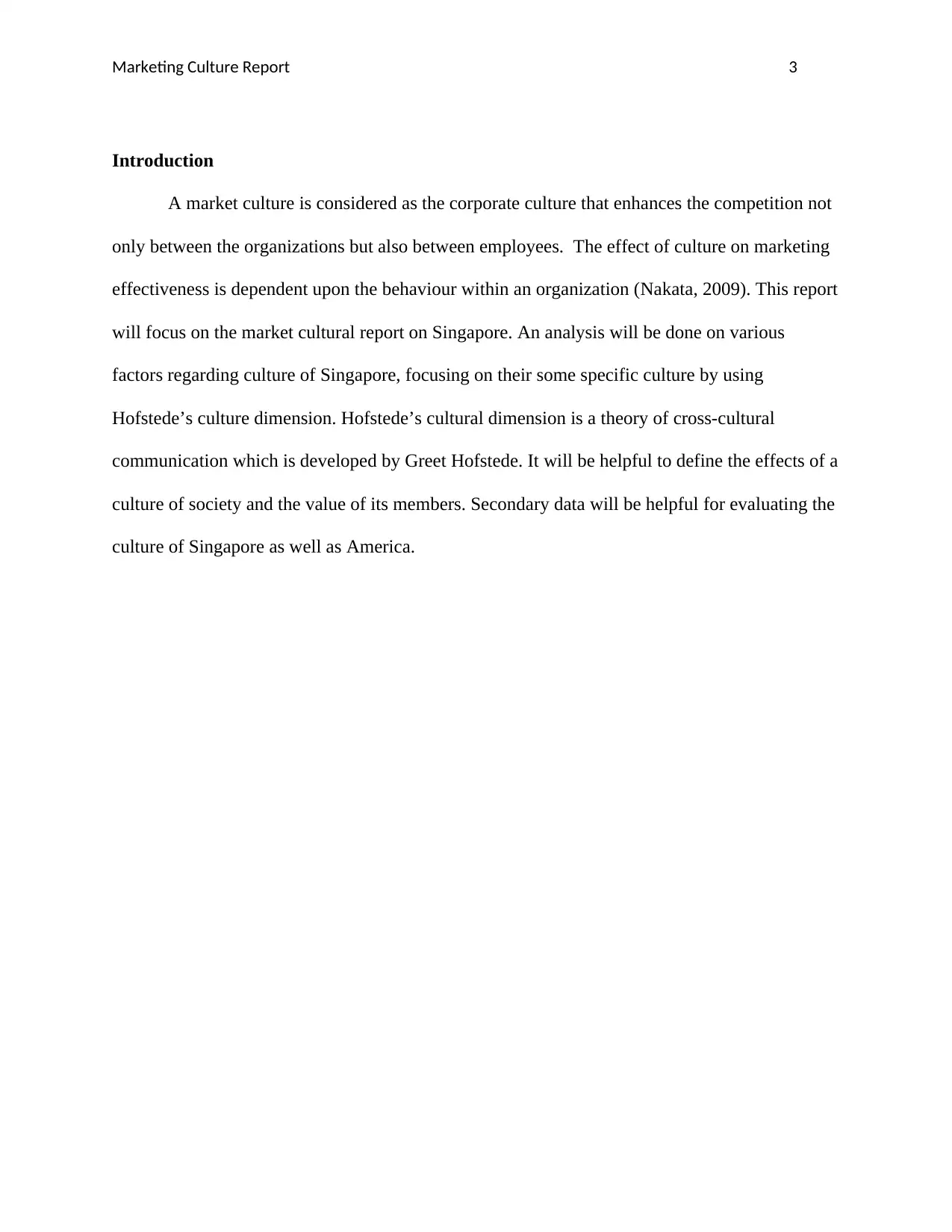
Marketing Culture Report 3
Introduction
A market culture is considered as the corporate culture that enhances the competition not
only between the organizations but also between employees. The effect of culture on marketing
effectiveness is dependent upon the behaviour within an organization (Nakata, 2009). This report
will focus on the market cultural report on Singapore. An analysis will be done on various
factors regarding culture of Singapore, focusing on their some specific culture by using
Hofstede’s culture dimension. Hofstede’s cultural dimension is a theory of cross-cultural
communication which is developed by Greet Hofstede. It will be helpful to define the effects of a
culture of society and the value of its members. Secondary data will be helpful for evaluating the
culture of Singapore as well as America.
Introduction
A market culture is considered as the corporate culture that enhances the competition not
only between the organizations but also between employees. The effect of culture on marketing
effectiveness is dependent upon the behaviour within an organization (Nakata, 2009). This report
will focus on the market cultural report on Singapore. An analysis will be done on various
factors regarding culture of Singapore, focusing on their some specific culture by using
Hofstede’s culture dimension. Hofstede’s cultural dimension is a theory of cross-cultural
communication which is developed by Greet Hofstede. It will be helpful to define the effects of a
culture of society and the value of its members. Secondary data will be helpful for evaluating the
culture of Singapore as well as America.
⊘ This is a preview!⊘
Do you want full access?
Subscribe today to unlock all pages.

Trusted by 1+ million students worldwide
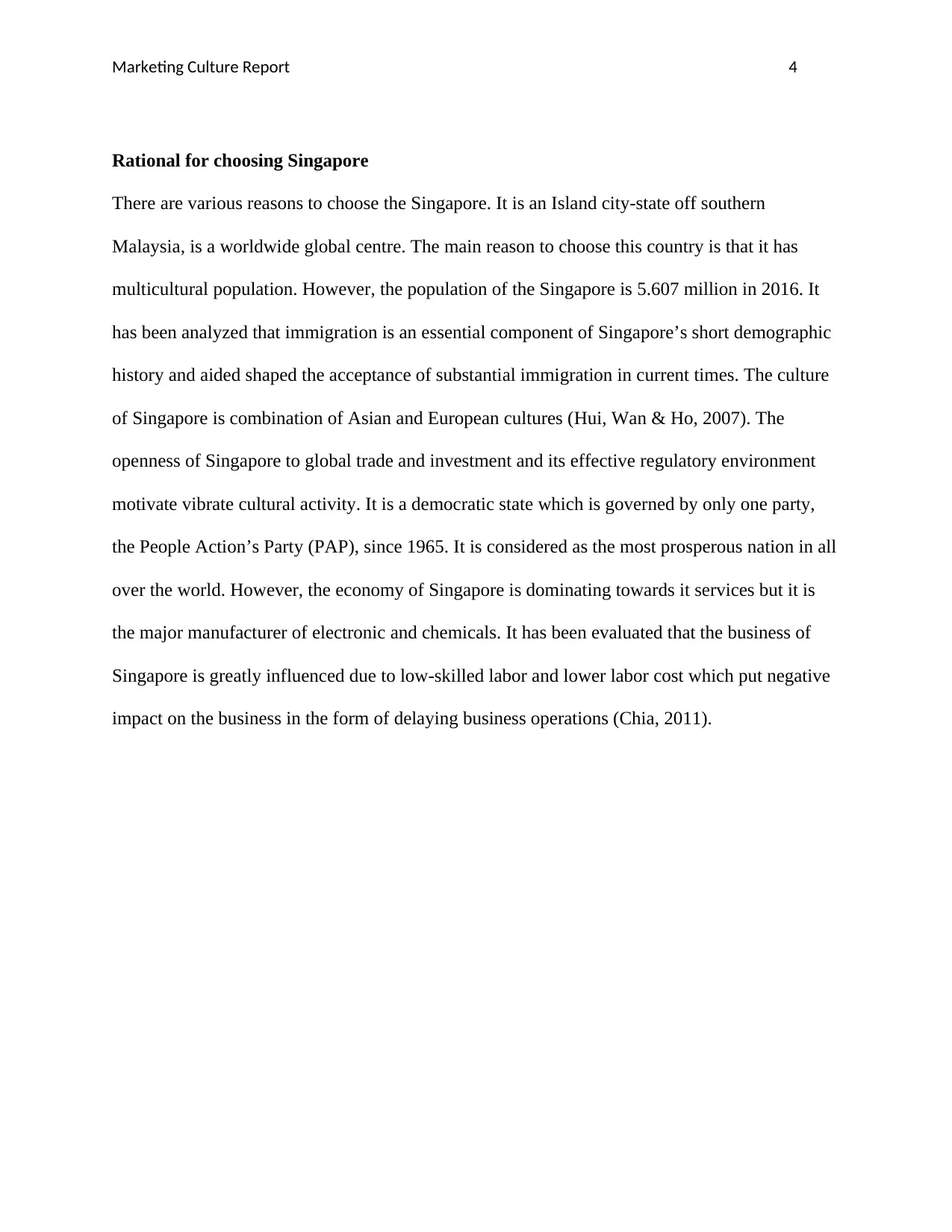
Marketing Culture Report 4
Rational for choosing Singapore
There are various reasons to choose the Singapore. It is an Island city-state off southern
Malaysia, is a worldwide global centre. The main reason to choose this country is that it has
multicultural population. However, the population of the Singapore is 5.607 million in 2016. It
has been analyzed that immigration is an essential component of Singapore’s short demographic
history and aided shaped the acceptance of substantial immigration in current times. The culture
of Singapore is combination of Asian and European cultures (Hui, Wan & Ho, 2007). The
openness of Singapore to global trade and investment and its effective regulatory environment
motivate vibrate cultural activity. It is a democratic state which is governed by only one party,
the People Action’s Party (PAP), since 1965. It is considered as the most prosperous nation in all
over the world. However, the economy of Singapore is dominating towards it services but it is
the major manufacturer of electronic and chemicals. It has been evaluated that the business of
Singapore is greatly influenced due to low-skilled labor and lower labor cost which put negative
impact on the business in the form of delaying business operations (Chia, 2011).
Rational for choosing Singapore
There are various reasons to choose the Singapore. It is an Island city-state off southern
Malaysia, is a worldwide global centre. The main reason to choose this country is that it has
multicultural population. However, the population of the Singapore is 5.607 million in 2016. It
has been analyzed that immigration is an essential component of Singapore’s short demographic
history and aided shaped the acceptance of substantial immigration in current times. The culture
of Singapore is combination of Asian and European cultures (Hui, Wan & Ho, 2007). The
openness of Singapore to global trade and investment and its effective regulatory environment
motivate vibrate cultural activity. It is a democratic state which is governed by only one party,
the People Action’s Party (PAP), since 1965. It is considered as the most prosperous nation in all
over the world. However, the economy of Singapore is dominating towards it services but it is
the major manufacturer of electronic and chemicals. It has been evaluated that the business of
Singapore is greatly influenced due to low-skilled labor and lower labor cost which put negative
impact on the business in the form of delaying business operations (Chia, 2011).
Paraphrase This Document
Need a fresh take? Get an instant paraphrase of this document with our AI Paraphraser
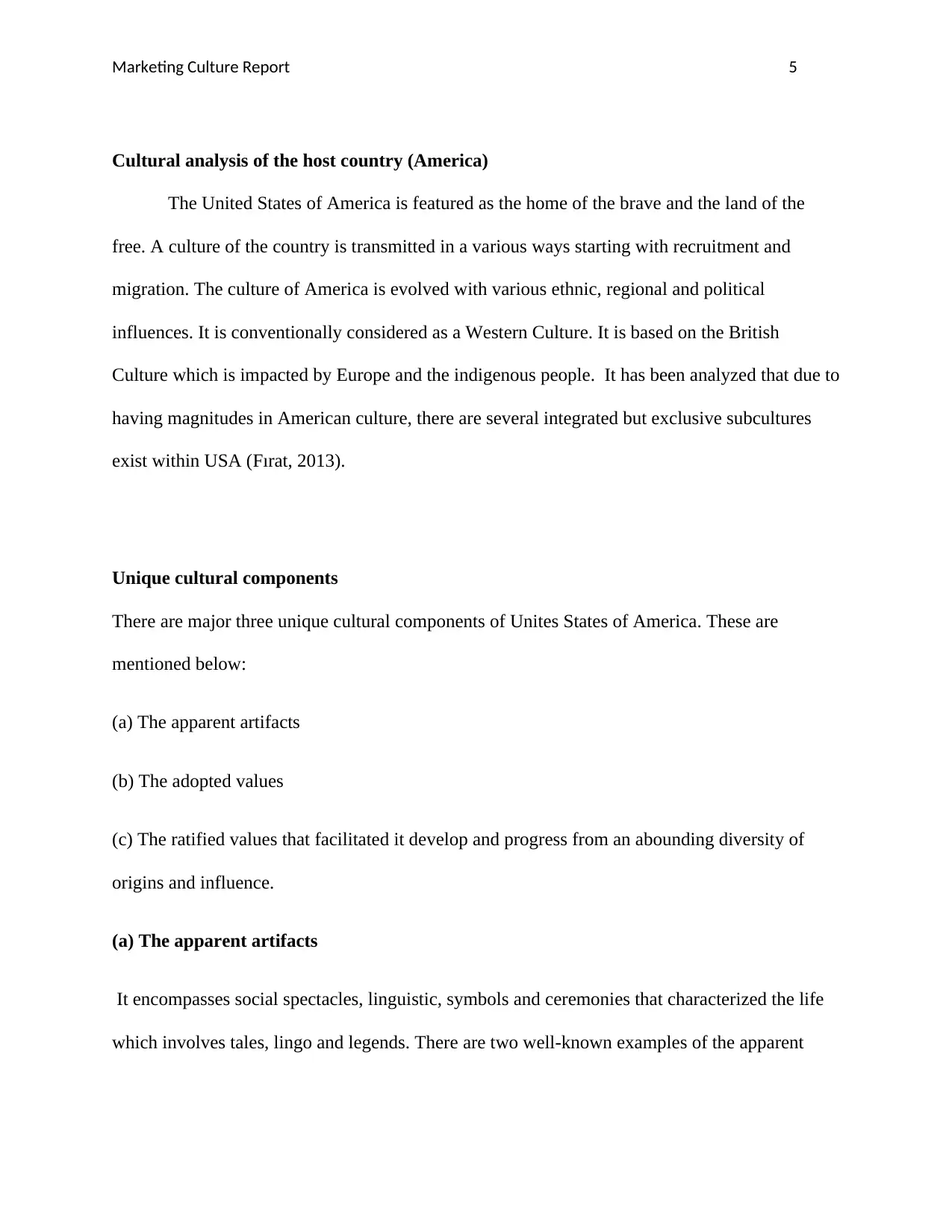
Marketing Culture Report 5
Cultural analysis of the host country (America)
The United States of America is featured as the home of the brave and the land of the
free. A culture of the country is transmitted in a various ways starting with recruitment and
migration. The culture of America is evolved with various ethnic, regional and political
influences. It is conventionally considered as a Western Culture. It is based on the British
Culture which is impacted by Europe and the indigenous people. It has been analyzed that due to
having magnitudes in American culture, there are several integrated but exclusive subcultures
exist within USA (Fırat, 2013).
Unique cultural components
There are major three unique cultural components of Unites States of America. These are
mentioned below:
(a) The apparent artifacts
(b) The adopted values
(c) The ratified values that facilitated it develop and progress from an abounding diversity of
origins and influence.
(a) The apparent artifacts
It encompasses social spectacles, linguistic, symbols and ceremonies that characterized the life
which involves tales, lingo and legends. There are two well-known examples of the apparent
Cultural analysis of the host country (America)
The United States of America is featured as the home of the brave and the land of the
free. A culture of the country is transmitted in a various ways starting with recruitment and
migration. The culture of America is evolved with various ethnic, regional and political
influences. It is conventionally considered as a Western Culture. It is based on the British
Culture which is impacted by Europe and the indigenous people. It has been analyzed that due to
having magnitudes in American culture, there are several integrated but exclusive subcultures
exist within USA (Fırat, 2013).
Unique cultural components
There are major three unique cultural components of Unites States of America. These are
mentioned below:
(a) The apparent artifacts
(b) The adopted values
(c) The ratified values that facilitated it develop and progress from an abounding diversity of
origins and influence.
(a) The apparent artifacts
It encompasses social spectacles, linguistic, symbols and ceremonies that characterized the life
which involves tales, lingo and legends. There are two well-known examples of the apparent
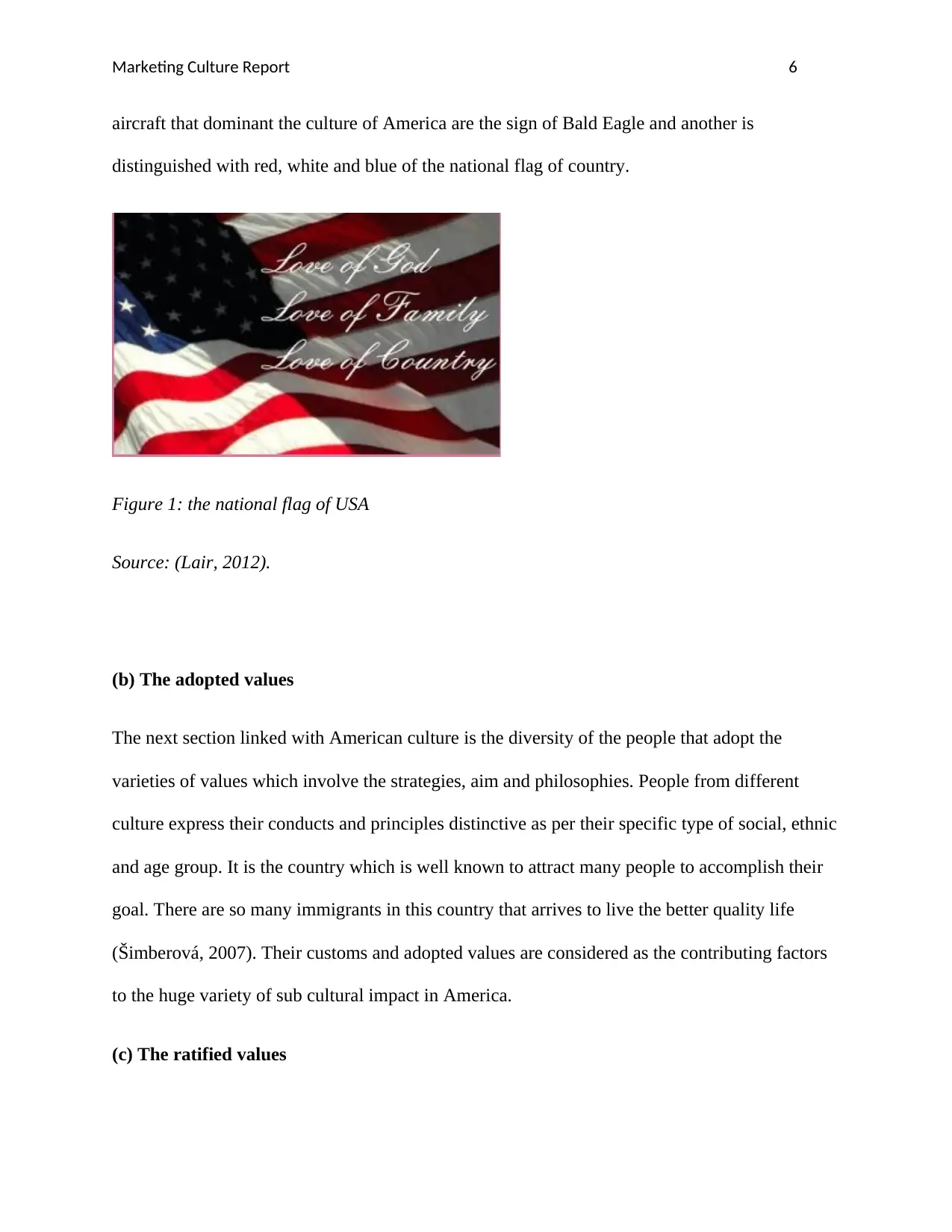
Marketing Culture Report 6
aircraft that dominant the culture of America are the sign of Bald Eagle and another is
distinguished with red, white and blue of the national flag of country.
Figure 1: the national flag of USA
Source: (Lair, 2012).
(b) The adopted values
The next section linked with American culture is the diversity of the people that adopt the
varieties of values which involve the strategies, aim and philosophies. People from different
culture express their conducts and principles distinctive as per their specific type of social, ethnic
and age group. It is the country which is well known to attract many people to accomplish their
goal. There are so many immigrants in this country that arrives to live the better quality life
(Šimberová, 2007). Their customs and adopted values are considered as the contributing factors
to the huge variety of sub cultural impact in America.
(c) The ratified values
aircraft that dominant the culture of America are the sign of Bald Eagle and another is
distinguished with red, white and blue of the national flag of country.
Figure 1: the national flag of USA
Source: (Lair, 2012).
(b) The adopted values
The next section linked with American culture is the diversity of the people that adopt the
varieties of values which involve the strategies, aim and philosophies. People from different
culture express their conducts and principles distinctive as per their specific type of social, ethnic
and age group. It is the country which is well known to attract many people to accomplish their
goal. There are so many immigrants in this country that arrives to live the better quality life
(Šimberová, 2007). Their customs and adopted values are considered as the contributing factors
to the huge variety of sub cultural impact in America.
(c) The ratified values
⊘ This is a preview!⊘
Do you want full access?
Subscribe today to unlock all pages.

Trusted by 1+ million students worldwide
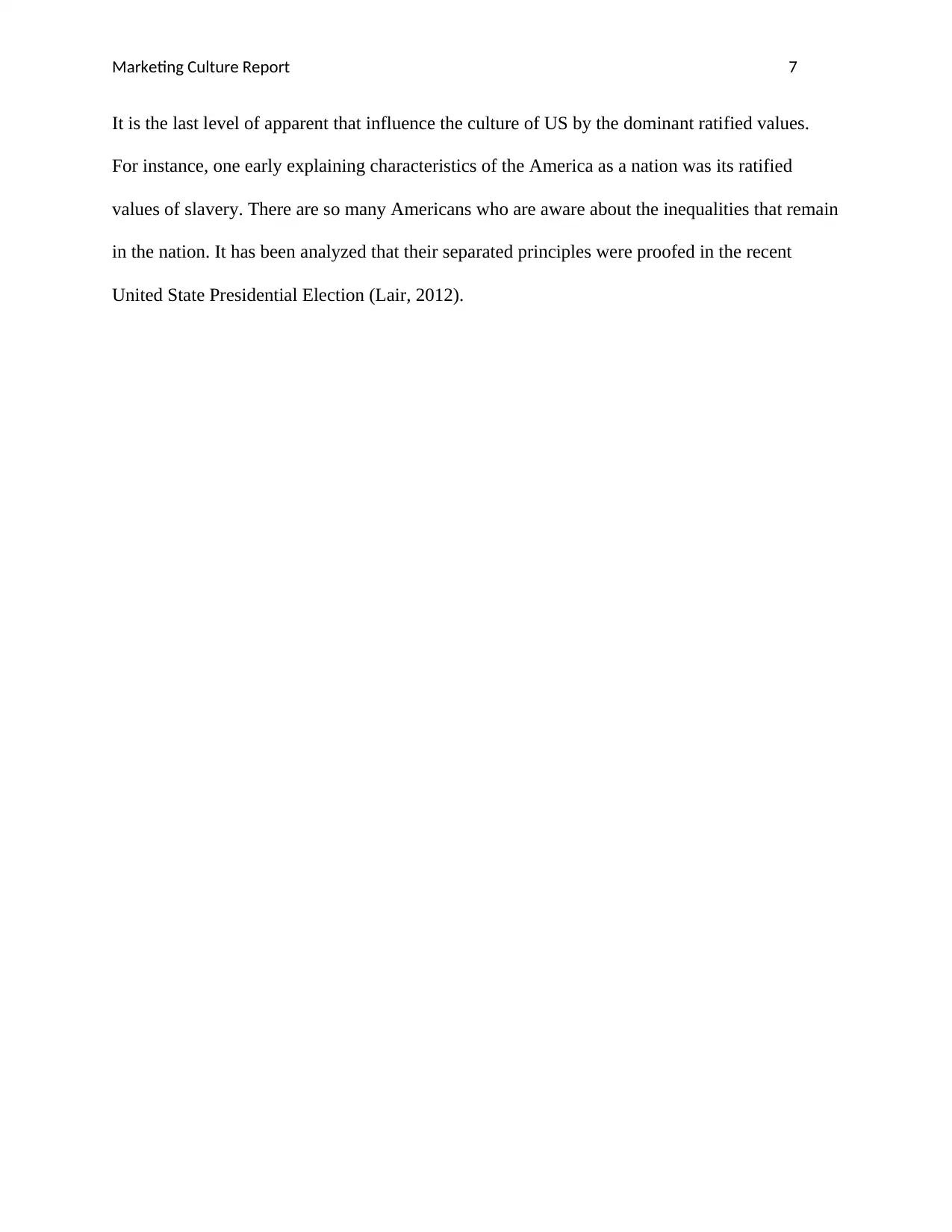
Marketing Culture Report 7
It is the last level of apparent that influence the culture of US by the dominant ratified values.
For instance, one early explaining characteristics of the America as a nation was its ratified
values of slavery. There are so many Americans who are aware about the inequalities that remain
in the nation. It has been analyzed that their separated principles were proofed in the recent
United State Presidential Election (Lair, 2012).
It is the last level of apparent that influence the culture of US by the dominant ratified values.
For instance, one early explaining characteristics of the America as a nation was its ratified
values of slavery. There are so many Americans who are aware about the inequalities that remain
in the nation. It has been analyzed that their separated principles were proofed in the recent
United State Presidential Election (Lair, 2012).
Paraphrase This Document
Need a fresh take? Get an instant paraphrase of this document with our AI Paraphraser
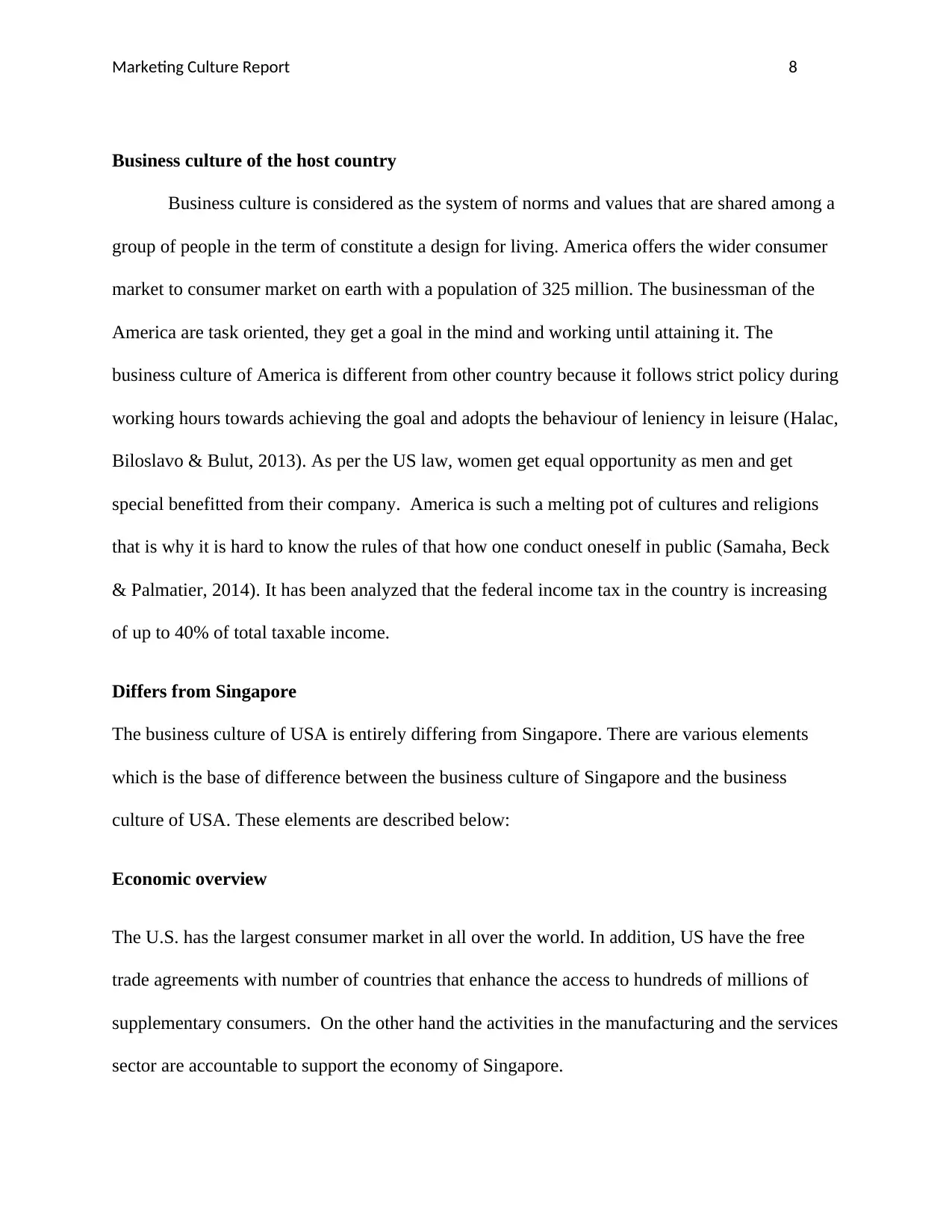
Marketing Culture Report 8
Business culture of the host country
Business culture is considered as the system of norms and values that are shared among a
group of people in the term of constitute a design for living. America offers the wider consumer
market to consumer market on earth with a population of 325 million. The businessman of the
America are task oriented, they get a goal in the mind and working until attaining it. The
business culture of America is different from other country because it follows strict policy during
working hours towards achieving the goal and adopts the behaviour of leniency in leisure (Halac,
Biloslavo & Bulut, 2013). As per the US law, women get equal opportunity as men and get
special benefitted from their company. America is such a melting pot of cultures and religions
that is why it is hard to know the rules of that how one conduct oneself in public (Samaha, Beck
& Palmatier, 2014). It has been analyzed that the federal income tax in the country is increasing
of up to 40% of total taxable income.
Differs from Singapore
The business culture of USA is entirely differing from Singapore. There are various elements
which is the base of difference between the business culture of Singapore and the business
culture of USA. These elements are described below:
Economic overview
The U.S. has the largest consumer market in all over the world. In addition, US have the free
trade agreements with number of countries that enhance the access to hundreds of millions of
supplementary consumers. On the other hand the activities in the manufacturing and the services
sector are accountable to support the economy of Singapore.
Business culture of the host country
Business culture is considered as the system of norms and values that are shared among a
group of people in the term of constitute a design for living. America offers the wider consumer
market to consumer market on earth with a population of 325 million. The businessman of the
America are task oriented, they get a goal in the mind and working until attaining it. The
business culture of America is different from other country because it follows strict policy during
working hours towards achieving the goal and adopts the behaviour of leniency in leisure (Halac,
Biloslavo & Bulut, 2013). As per the US law, women get equal opportunity as men and get
special benefitted from their company. America is such a melting pot of cultures and religions
that is why it is hard to know the rules of that how one conduct oneself in public (Samaha, Beck
& Palmatier, 2014). It has been analyzed that the federal income tax in the country is increasing
of up to 40% of total taxable income.
Differs from Singapore
The business culture of USA is entirely differing from Singapore. There are various elements
which is the base of difference between the business culture of Singapore and the business
culture of USA. These elements are described below:
Economic overview
The U.S. has the largest consumer market in all over the world. In addition, US have the free
trade agreements with number of countries that enhance the access to hundreds of millions of
supplementary consumers. On the other hand the activities in the manufacturing and the services
sector are accountable to support the economy of Singapore.
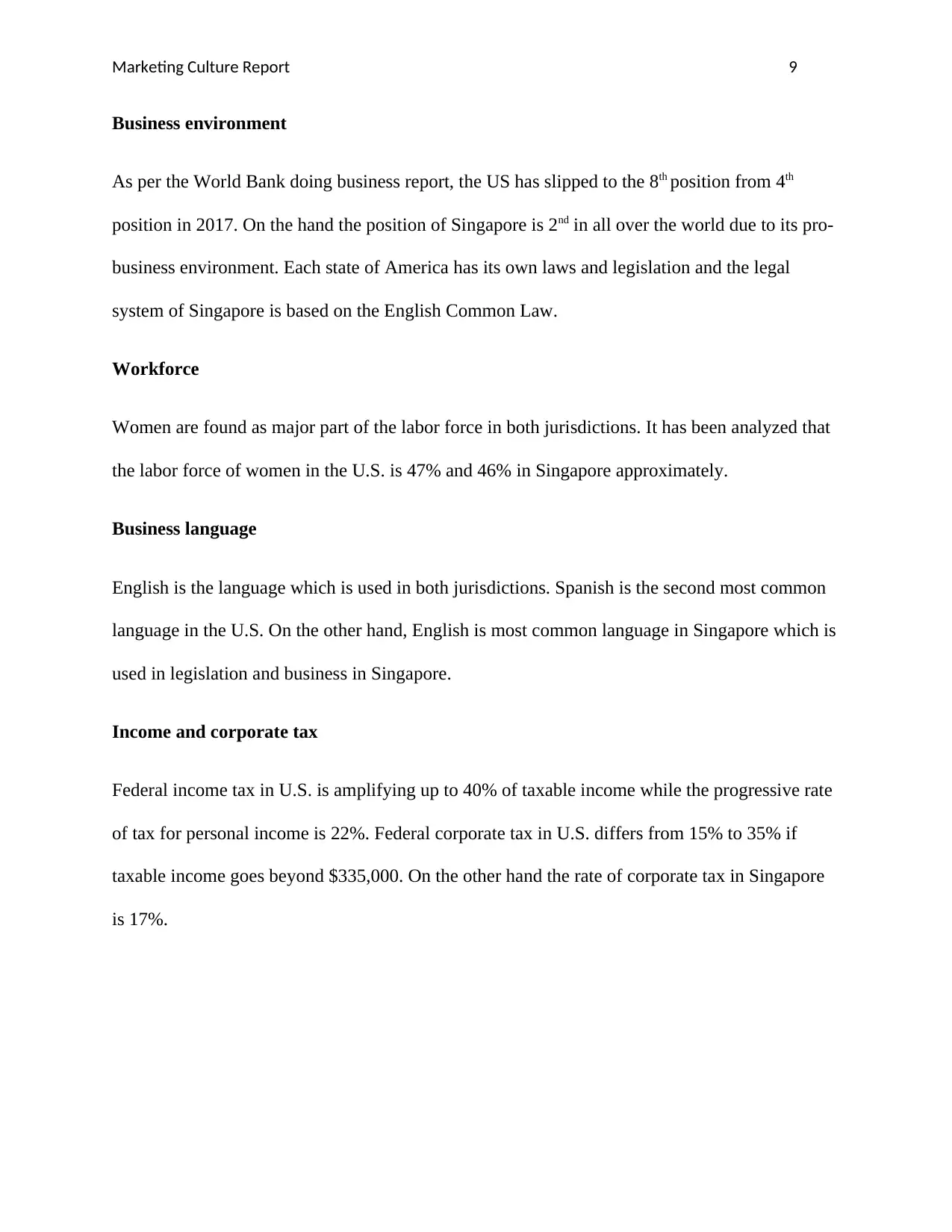
Marketing Culture Report 9
Business environment
As per the World Bank doing business report, the US has slipped to the 8th position from 4th
position in 2017. On the hand the position of Singapore is 2nd in all over the world due to its pro-
business environment. Each state of America has its own laws and legislation and the legal
system of Singapore is based on the English Common Law.
Workforce
Women are found as major part of the labor force in both jurisdictions. It has been analyzed that
the labor force of women in the U.S. is 47% and 46% in Singapore approximately.
Business language
English is the language which is used in both jurisdictions. Spanish is the second most common
language in the U.S. On the other hand, English is most common language in Singapore which is
used in legislation and business in Singapore.
Income and corporate tax
Federal income tax in U.S. is amplifying up to 40% of taxable income while the progressive rate
of tax for personal income is 22%. Federal corporate tax in U.S. differs from 15% to 35% if
taxable income goes beyond $335,000. On the other hand the rate of corporate tax in Singapore
is 17%.
Business environment
As per the World Bank doing business report, the US has slipped to the 8th position from 4th
position in 2017. On the hand the position of Singapore is 2nd in all over the world due to its pro-
business environment. Each state of America has its own laws and legislation and the legal
system of Singapore is based on the English Common Law.
Workforce
Women are found as major part of the labor force in both jurisdictions. It has been analyzed that
the labor force of women in the U.S. is 47% and 46% in Singapore approximately.
Business language
English is the language which is used in both jurisdictions. Spanish is the second most common
language in the U.S. On the other hand, English is most common language in Singapore which is
used in legislation and business in Singapore.
Income and corporate tax
Federal income tax in U.S. is amplifying up to 40% of taxable income while the progressive rate
of tax for personal income is 22%. Federal corporate tax in U.S. differs from 15% to 35% if
taxable income goes beyond $335,000. On the other hand the rate of corporate tax in Singapore
is 17%.
⊘ This is a preview!⊘
Do you want full access?
Subscribe today to unlock all pages.

Trusted by 1+ million students worldwide
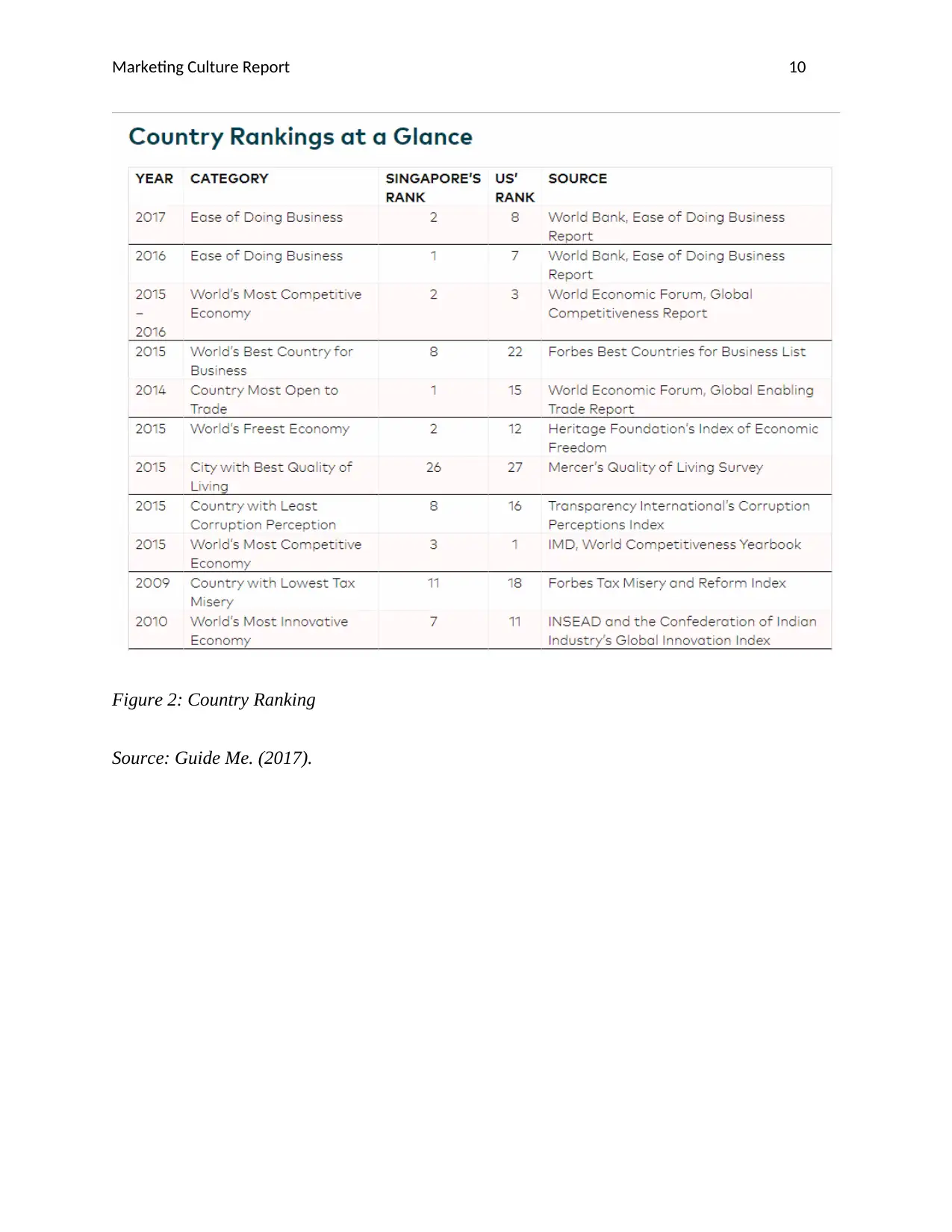
Marketing Culture Report 10
Figure 2: Country Ranking
Source: Guide Me. (2017).
Figure 2: Country Ranking
Source: Guide Me. (2017).
Paraphrase This Document
Need a fresh take? Get an instant paraphrase of this document with our AI Paraphraser
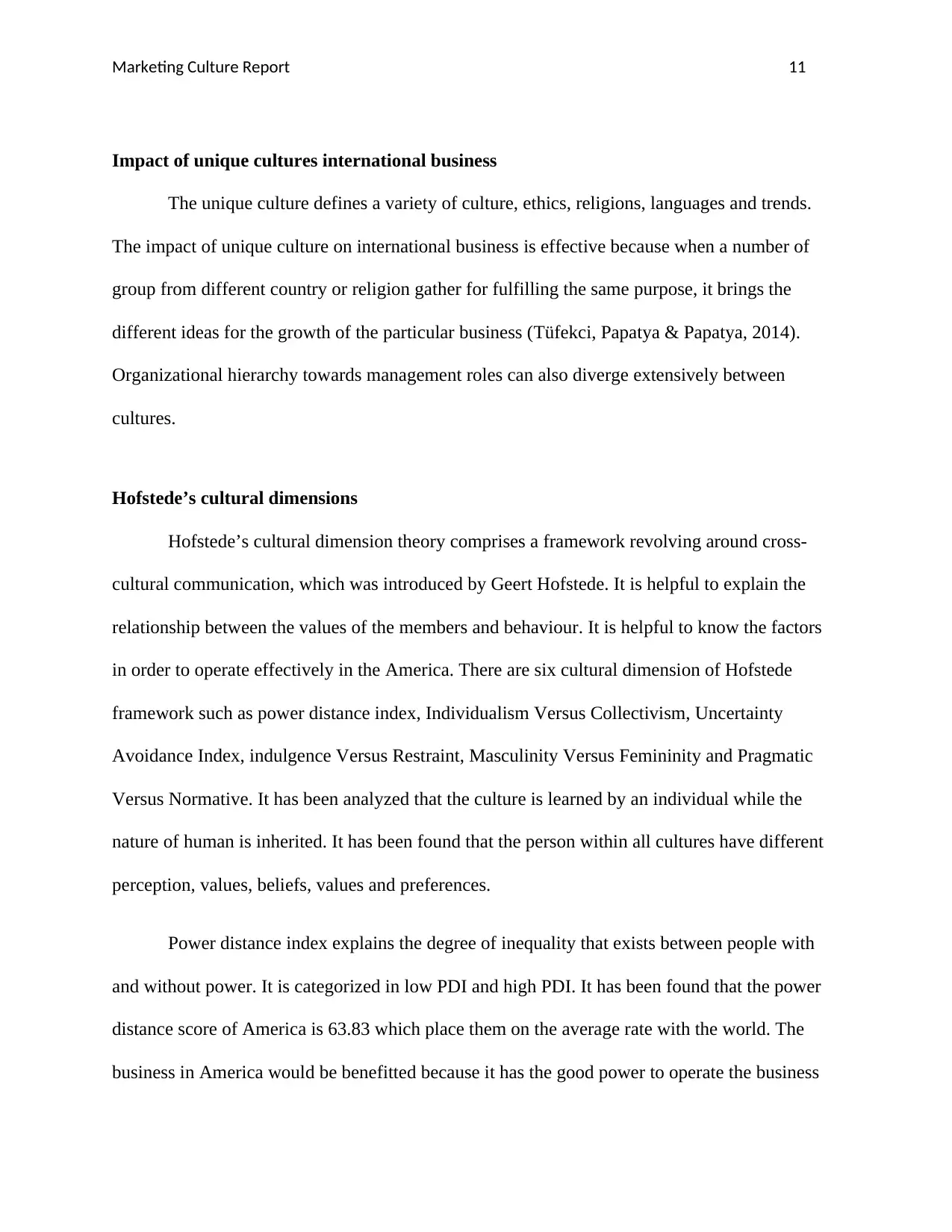
Marketing Culture Report 11
Impact of unique cultures international business
The unique culture defines a variety of culture, ethics, religions, languages and trends.
The impact of unique culture on international business is effective because when a number of
group from different country or religion gather for fulfilling the same purpose, it brings the
different ideas for the growth of the particular business (Tüfekci, Papatya & Papatya, 2014).
Organizational hierarchy towards management roles can also diverge extensively between
cultures.
Hofstede’s cultural dimensions
Hofstede’s cultural dimension theory comprises a framework revolving around cross-
cultural communication, which was introduced by Geert Hofstede. It is helpful to explain the
relationship between the values of the members and behaviour. It is helpful to know the factors
in order to operate effectively in the America. There are six cultural dimension of Hofstede
framework such as power distance index, Individualism Versus Collectivism, Uncertainty
Avoidance Index, indulgence Versus Restraint, Masculinity Versus Femininity and Pragmatic
Versus Normative. It has been analyzed that the culture is learned by an individual while the
nature of human is inherited. It has been found that the person within all cultures have different
perception, values, beliefs, values and preferences.
Power distance index explains the degree of inequality that exists between people with
and without power. It is categorized in low PDI and high PDI. It has been found that the power
distance score of America is 63.83 which place them on the average rate with the world. The
business in America would be benefitted because it has the good power to operate the business
Impact of unique cultures international business
The unique culture defines a variety of culture, ethics, religions, languages and trends.
The impact of unique culture on international business is effective because when a number of
group from different country or religion gather for fulfilling the same purpose, it brings the
different ideas for the growth of the particular business (Tüfekci, Papatya & Papatya, 2014).
Organizational hierarchy towards management roles can also diverge extensively between
cultures.
Hofstede’s cultural dimensions
Hofstede’s cultural dimension theory comprises a framework revolving around cross-
cultural communication, which was introduced by Geert Hofstede. It is helpful to explain the
relationship between the values of the members and behaviour. It is helpful to know the factors
in order to operate effectively in the America. There are six cultural dimension of Hofstede
framework such as power distance index, Individualism Versus Collectivism, Uncertainty
Avoidance Index, indulgence Versus Restraint, Masculinity Versus Femininity and Pragmatic
Versus Normative. It has been analyzed that the culture is learned by an individual while the
nature of human is inherited. It has been found that the person within all cultures have different
perception, values, beliefs, values and preferences.
Power distance index explains the degree of inequality that exists between people with
and without power. It is categorized in low PDI and high PDI. It has been found that the power
distance score of America is 63.83 which place them on the average rate with the world. The
business in America would be benefitted because it has the good power to operate the business
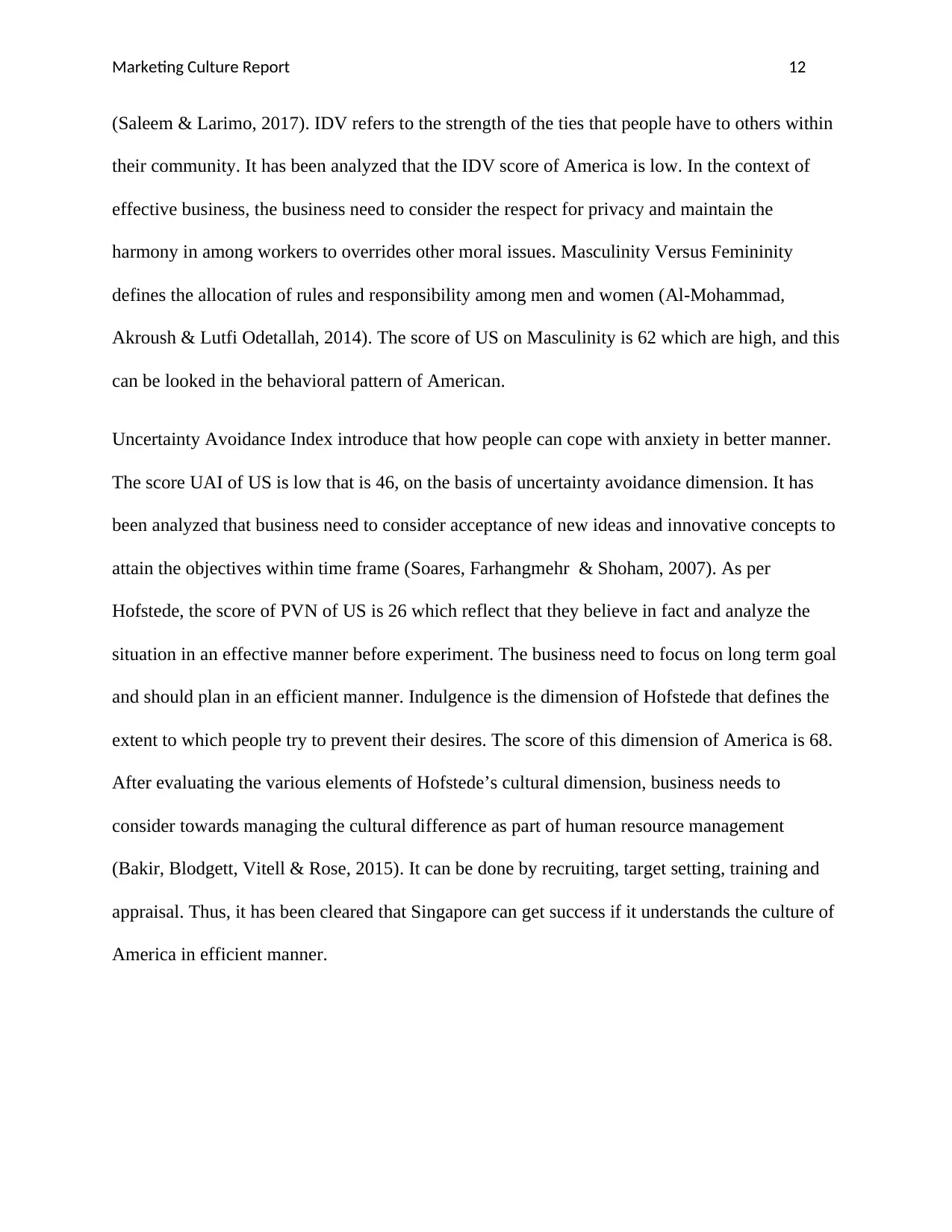
Marketing Culture Report 12
(Saleem & Larimo, 2017). IDV refers to the strength of the ties that people have to others within
their community. It has been analyzed that the IDV score of America is low. In the context of
effective business, the business need to consider the respect for privacy and maintain the
harmony in among workers to overrides other moral issues. Masculinity Versus Femininity
defines the allocation of rules and responsibility among men and women (Al-Mohammad,
Akroush & Lutfi Odetallah, 2014). The score of US on Masculinity is 62 which are high, and this
can be looked in the behavioral pattern of American.
Uncertainty Avoidance Index introduce that how people can cope with anxiety in better manner.
The score UAI of US is low that is 46, on the basis of uncertainty avoidance dimension. It has
been analyzed that business need to consider acceptance of new ideas and innovative concepts to
attain the objectives within time frame (Soares, Farhangmehr & Shoham, 2007). As per
Hofstede, the score of PVN of US is 26 which reflect that they believe in fact and analyze the
situation in an effective manner before experiment. The business need to focus on long term goal
and should plan in an efficient manner. Indulgence is the dimension of Hofstede that defines the
extent to which people try to prevent their desires. The score of this dimension of America is 68.
After evaluating the various elements of Hofstede’s cultural dimension, business needs to
consider towards managing the cultural difference as part of human resource management
(Bakir, Blodgett, Vitell & Rose, 2015). It can be done by recruiting, target setting, training and
appraisal. Thus, it has been cleared that Singapore can get success if it understands the culture of
America in efficient manner.
(Saleem & Larimo, 2017). IDV refers to the strength of the ties that people have to others within
their community. It has been analyzed that the IDV score of America is low. In the context of
effective business, the business need to consider the respect for privacy and maintain the
harmony in among workers to overrides other moral issues. Masculinity Versus Femininity
defines the allocation of rules and responsibility among men and women (Al-Mohammad,
Akroush & Lutfi Odetallah, 2014). The score of US on Masculinity is 62 which are high, and this
can be looked in the behavioral pattern of American.
Uncertainty Avoidance Index introduce that how people can cope with anxiety in better manner.
The score UAI of US is low that is 46, on the basis of uncertainty avoidance dimension. It has
been analyzed that business need to consider acceptance of new ideas and innovative concepts to
attain the objectives within time frame (Soares, Farhangmehr & Shoham, 2007). As per
Hofstede, the score of PVN of US is 26 which reflect that they believe in fact and analyze the
situation in an effective manner before experiment. The business need to focus on long term goal
and should plan in an efficient manner. Indulgence is the dimension of Hofstede that defines the
extent to which people try to prevent their desires. The score of this dimension of America is 68.
After evaluating the various elements of Hofstede’s cultural dimension, business needs to
consider towards managing the cultural difference as part of human resource management
(Bakir, Blodgett, Vitell & Rose, 2015). It can be done by recruiting, target setting, training and
appraisal. Thus, it has been cleared that Singapore can get success if it understands the culture of
America in efficient manner.
⊘ This is a preview!⊘
Do you want full access?
Subscribe today to unlock all pages.

Trusted by 1+ million students worldwide
1 out of 17
Related Documents
Your All-in-One AI-Powered Toolkit for Academic Success.
+13062052269
info@desklib.com
Available 24*7 on WhatsApp / Email
![[object Object]](/_next/static/media/star-bottom.7253800d.svg)
Unlock your academic potential
Copyright © 2020–2025 A2Z Services. All Rights Reserved. Developed and managed by ZUCOL.





